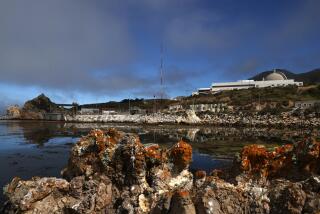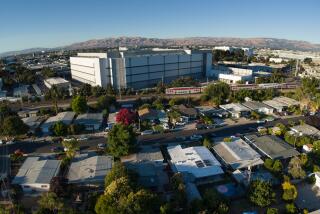Proposed Power Plants Will Energize Open Market
- Share via
The opening up of California’s electricity market has triggered proposals for five big new power plants across the state totaling nearly $2 billion in private investment, marking the first major non-nuclear power projects in California in more than 20 years, developers and state officials said Friday.
The plants, including a $500-million facility in San Diego and a $660-million project in Victorville, would produce about 2,000 megawatts of electricity--equal to about 4% of the state’s current fossil fuel-powered generating capacity.
They would be the first in a new generation of high-technology “merchant” power plants built not by public utilities but by corporations and entrepreneurs risking big dollars on their ability to generate low-cost energy and market it both inside and outside California.
Four of the five plants would be powered by natural gas, a relatively clean-burning fossil fuel. A fifth, planned for Belridge in Kern County, would be a cogeneration plant. The additional projects are proposed for Livingston, in Merced County, and Yuba City in Sutter County.
Developers will need approval from state and local environmental regulators as well as the California Energy Commission, which disclosed the proposed projects Friday. But in the new, deregulated energy market, the projects won’t need the blessing of the Federal Energy Regulatory Commission.
“We are responding to the fact that Californians and anyone else in a high-priced energy market will demand choice in low cost electricity,” said Katherine Potter, spokeswoman for Calpine, a San Jose-based independent power producer proposing a $450-million, 500-megawatt energy plant in Yuba City that would begin construction in 1999.
Starting Jan. 1, the state’s electric utilities will lose their monopolies and will no longer have captive markets for the electric power they generate. They and other energy producers will sell electricity directly to customers or to a state Power Exchange, which will function much like a commodities market.
The new plant developers, which range from independent entrepreneurial firms to consortiums of major utilities and construction companies, are betting that they can produce energy cheaply enough to sell their electricity.
Over time, consumers will be free to buy via the exchange, or “PX” as it has been dubbed, from the lowest cost producer, meaning that the most efficiently run power plants will win out. The PX will be independently operated and act as a broker and traffic cop to ensure the reliability and fairness of the market.
“All power plants including those owned by utilities will have to make it on their own,” said Frank De Rosa, western region vice president for U.S. Generating Co., the company proposing the San Diego plant. It is a joint venture of Bechtel Corp. and Pacific Gas & Electric Co., the San Francisco-based utility.
Most will be highly automated: The San Diego plant, sprawled over 10 acres, would have only 19 employees. Its new technology means the plant will emit 40% less toxic nitrogen oxide than even retrofitted older generation plants produce.
It will generate 660 megawatts, about one-fourth the capacity of the two nuclear units at San Onofre. It is proposed for the Otay Mesa area of San Diego County, a mile and a half north of the U.S.-Mexico border. Developers hope to begin construction next year and complete it in 1999.
Its power could be sold within California, to other Western states or to Mexico, where demand for energy in fast-growing border cities like Tijuana is soaring. The new plant will also be tailor made to provide power to San Diego at times when peak demand exceeds supply, which is expected to happen with increasing frequency in coming years.
Ironically, the proposals come as utilities are in the process of selling off or closing many existing fossil fuel-burning plants that are dirtier than new-generation plants and are costly to operate. PG & E is selling four of its power plants, and Southern California Edison has put 12 plants on the block, in response to a state edict that utilities reduce their power dominance.
“The new power plant technology is much cleaner by a long shot than anything existing that the utilities own, partly because the state pollution requirements are much more stringent for new power plants coming on stream than for the old ones,” said V. John White, executive director of Center for Energy Efficiency and Renewable Technologies, a Sacramento-based environmental think tank.
A 680-megawatt facility is proposed for the High Desert area near Victorville. The developers include Constellation Energy, a unit of Baltimore Gas and Electric, and Inland Group. Cost is estimated by the California Energy Commission at more than $600 million.
Two other plants are considerably smaller. Bock Energy of Denver has proposed a $140-million plant in Livingston, Merced County, producing 113 megawatts. In Belridge, a $125-million, 177-megawatt plant would burn oil recovered from fields in the region.
More to Read
Inside the business of entertainment
The Wide Shot brings you news, analysis and insights on everything from streaming wars to production — and what it all means for the future.
You may occasionally receive promotional content from the Los Angeles Times.










